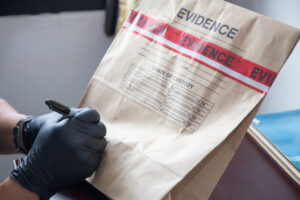
Strong evidence is the foundation of every successful personal injury case. The documentation you collect—from medical records to witness statements—can make the difference between a favorable settlement and a denied claim.
This guide will help you understand what evidence you can gather and how to protect your right to compensation.
What Is Evidence in a Personal Injury Case?

The types of evidence in North Carolina personal injury cases include:
Medical Records
You must prove the types of injuries you sustained and the extent of your injuries. Medical records provide an accurate and detailed accounting of your injuries and your medical treatment.
Examples of medical records include:
- Emergency room records
- Records from doctors and specialists
- Hospital records
- Physical, occupational, and other rehabilitative treatment records
- Records from mental health treatment and counseling
- Surgical records
- Lab and diagnostic records
- Records from emergency medical services
These records also provide key evidence about permanent impairments and the cost of medical care.
Employment Records
Another significant economic damage in a personal injury case is lost wages. Employment and financial records establish how much money you earned before the accident.
Examples of evidence used for lost wages include:
- Pay stubs
- Tax returns
- Income statements
- W2s, 1099s, etc.
- A statement from your employer
This information is necessary to calculate your lost wages, diminished earning capacity, and loss of employment benefits.
Police and Accident Records
Accident and police reports include facts about the incident that can be useful when gathering evidence for a personal injury claim. These reports contain information about the parties involved, insurance coverage, witnesses, and the officer’s observations. While some of the information in an accident report may not be admitted into evidence, an attorney can use these documents to gather facts and information to build a case.
Videos and Photographs
An accident may be captured on video, such as a traffic camera filming a car accident or a surveillance camera capturing a slip and fall accident. Video of an accident or incident can be compelling evidence to prove causation and fault for a personal injury claim.
Photographs of the accident scene can also be used as evidence because they offer a visual presentation of the aftermath of an accident. This can help jurors “see” the extent of the accident and establish facts about the circumstances that caused it.
Witness Statements
Eyewitness testimony can be compelling because the witness does not have a stake in the outcome of the case. Their testimony can add credibility to your statement of how an injury or accident occurred. By corroborating your story, an eyewitness can strengthen the evidence confirming liability.
Your testimony can help establish the facts of the case and give jurors context for the extent of your pain and suffering and other non-economic damages.
Expert Witnesses
A personal injury lawyer may retain one or more experts to assist with your case.
Expert witnesses in a personal injury case may include:
- Medical specialists
- Accident reconstructionists
- Engineers and architects
- Trucking industry experts
- Manufacturing experts
- Scientists
- Financial professionals
Experts have specialized education, knowledge, training, and/or skills in a specific subject. Their testimony helps jurors make informed decisions regarding particular facts of the case.
Electronic Communication and Social Media Posts
Insurance companies often search the internet and electronic communications for evidence to use against accident victims. The insurance company may use your social media posts to allege your injuries are less severe than you claim. For instance, it might point to a video of you at a party to allege that you can do more than you claim.
Documentation and Physical Evidence
Tangible items can be introduced as evidence. For instance, a defective product may be used as evidence in a product liability case. Forensic evidence in North Carolina may help prove certain elements of a case. Text messages and data records are also examples of documentary evidence.
Presenting Courtroom Evidence in Raleigh, NC
The North Carolina Rules of Evidence dictate the types of evidence that are admissible in court. For instance, hearsay is often inadmissible in court, and evidence obtained in an illegal search and seizure may be inadmissible in a criminal case. An experienced personal injury lawyer can gather, preserve, and use evidence to build cases that give their clients the best chance of obtaining a successful outcome.
Contact Riddle & Riddle Injury Lawyers for a Free Consultation With a Raleigh Personal Injury Lawyer
Gathering the right evidence is critical to your case if you’ve been injured due to someone else’s negligence. At Riddle & Riddle Injury Lawyers, our Raleigh personal injury attorneys are here to guide you every step of the way.
Contact us today at (919) 876-3020 to schedule a free consultation and learn how we can help you pursue the compensation you deserve.
